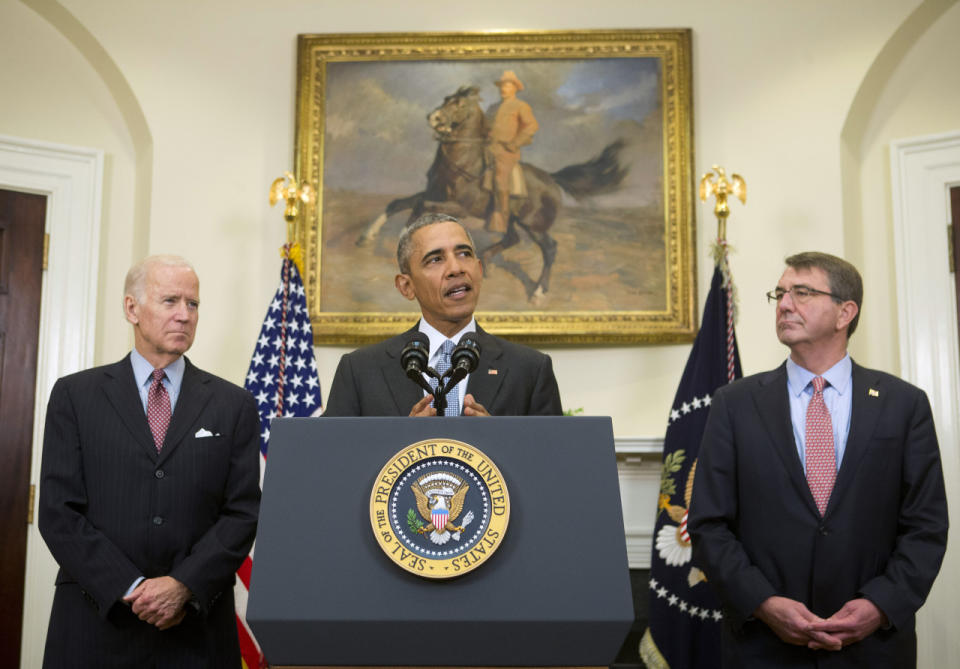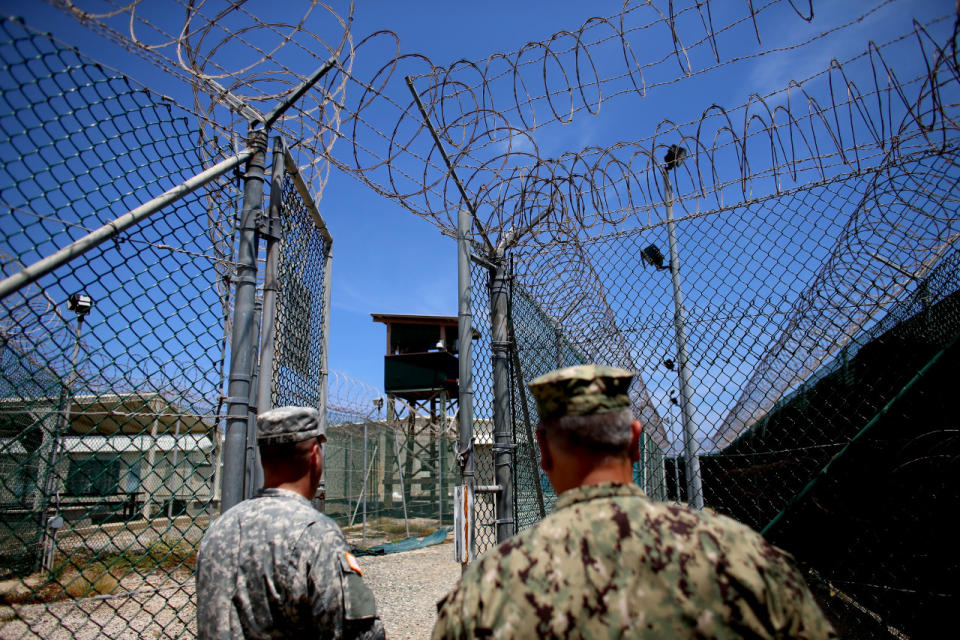Obama sends Congress a plan to close Guantánamo Bay
In what may be his final push to close Guantánamo Bay before leaving office, President Obama on Tuesday sent Congress a blueprint for emptying the notorious prison of detainees and resettling scores of them in an unspecified facility on U.S. soil. The plan was widely seen as dead on arrival at the Capitol, where Obama’s on-again, off-again, seven-year campaign to shutter the jail has repeatedly met with Republican-dominated but bipartisan opposition.
“I don’t want to pass this problem on to the next president, whoever it is,” Obama told reporters in the Roosevelt Room of the White House. “With this plan, we have the opportunity, finally, to eliminate a terrorist propaganda tool, strengthen relationships with allies and partners, enhance our national security and most importantly uphold the values that bind us as Americans.”
Lawmakers were expected to reject Obama’s proposal, raising the possibility that Obama might resort to executive action that could spark a major election-year clash. Congress has repeatedly passed – and the president signed – legislation forbidding the transfer of Guantánamo Bay detainees to U.S. soil.
The new blueprint reflects months of work by the Obama administration to identify likely destinations for the inmates at the base, which is near Cuba’s southeastern tip.
Officials looked at 13 potential facilities, including state and federal prisons as well as military bases, but the plan does not identify a specific alternative.
“We’re going to keep making the case to Congress that we can do this in a responsible and secure way,” Obama said.
But Republican Representative Mac Thornberry, who chairs the House Armed Services Committee, gave the proposal a chilly welcome.
“What the president submitted today is more press release than a plan,” he said in a statement. “I have pledged to give the president’s plan a fair hearing, but he makes it impossible to do so when he withholds critical details.”

President Obama, accompanied by Vice President Joe Biden and Defense Secretary Ash Carter, discusses the detention center at Guantanamo Bay on Feb. 23. (Photo: Pablo Martinez Monsivais/AP)
The facility at Guantánamo Bay currently houses 91 detainees, of whom 35 have been cleared for transfer to other countries and may leave “in the next several months,” a senior U.S. official told reporters on a conference call organized by the White House. Another 10 are in the process of being tried by military commissions. The remaining 46 include two dozen whom the government has decided it cannot prosecute but who are thought to be too dangerous to release. The prison population reached its peak in 2003 at about 680 detainees.
On the conference call, U.S. officials told reporters that the plan calls for moving 30-60 prisoners to sites in the United States, where they would continue to be guarded by military personnel. There would be a one-time cost to upgrade the new facility and move the detainees, roughly $290 million to $475 million, the officials said. But the new arrangement would cost $65 million to $85 million less annually.
U.S. officials said on the call that the prisoners would be held under the 2001 Authorization for Use of Military Force that underpins the entire war on terrorism, meaning that they would not acquire new legal rights to challenge their detention if moved to U.S. soil.
In his remarks, Obama noted the sluggish pace of military trials at the tropical base, underlining that not one of those connected to the attacks of Sept. 11, 2001, attacks has been convicted. And he emphasized that federal courts have been far speedier, noting the trials and convictions of “shoe-bomber” Richard Reid or Boston marathon bomber Dzhokhar Tsarnaev.
Still, the proposed arrangement would confirm Obama’s tacit acceptance that the United States will indefinitely detain some prisoners without ever bringing them to trial, something likely to anger civil liberties advocates.
And even if Congress were to spin 180 degrees and embrace the plan, it is unclear that the construction and transfer could occur quickly enough for Obama to be able to make good on his 2008 promise to close the facility during his presidency.
Since taking office, Obama has repeatedly argued that the prison serves as a recruitment tool for extremist groups while making it harder for some U.S. allies to cooperate with Washington. Recently, the president has increasingly couched his position in fiscal terms, noting that the facility is enormously expensive.
The proposal is sure to echo across the 2016 presidential campaign battlefield. Hillary Clinton and Bernie Sanders, the Democratic rivals to succeed Obama, both favor closing the prison. The contenders for the Republican nomination oppose doing so. Of the candidates seeking the White House, only Republican Sen. Marco Rubio is known to have visited Guantánamo Bay.
Some GOP critics have accused the Obama administration – and the Bush administration before it – of being too quick to release prisoners who then attack American interests overseas. Others have worried that bringing detainees to U.S. soil may pose a security risk to American communities.
Few policy battles have defined Obama’s time in office like this one.
On his first full day in office, Obama signed an executive order to close the facility. In his first speech to a joint session of Congress one month later, he said it was important to do so in order to be true to American values. Throughout his tumultuous presidency, Obama has come back again and again to his warning that Guantánamo Bay serves as a rallying cry for Islamist extremists.
“The existence of Guantánamo likely created more terrorists around the world than it ever detained,” he charged in May 2009.

Camp Delta is part of the U.S. military prison for “enemy combatants” in Guantanamo Bay, Cuba. (Photo: Joe Raedle/Getty Images)
But that same month, one of Obama’s top liberal allies in Congress dealt the closure plan a blow from which it never really recovered. House Appropriations Committee Chairman Dave Obey stripped $80 million that Obama had requested to close the prison from an emergency funding bill.
“While I don’t mind defending a concrete program, I’m not much interested in wasting my energy defending a theoretical program,” Obey said at the time. “So when they have a plan, they’re welcome to come back and talk to us about it.“
The White House response was relatively muted, and some House Democrats who supported Obama’s call for shuttering Guantánamo grumbled that Obama’s chief of staff at the time, Rahm Emanuel, had put doing so on the back burner while the young administration pursued other priorities, like overhauling the U.S. health insurance system. Emanuel was known to have clashed with Greg Craig, the high-powered Washington lawyer to whom Obama entrusted the Guantánamo Bay closure mission. Craig left the White House in late 2009.
And the plan slammed into Republican-led but bipartisan opposition in Congress. After his 2009 speech, Obama dropped Guantánamo from his State of the Union speeches in 2010, 2011, 2012 and 2013.
In 2013, the president grew increasingly concerned about a widespread hunger strike among Guantánamo Bay prisoners – one that the top military official in charge of the base, Marine Gen. John Kelly, essentially laid at Obama’s feet.
“They had great optimism that Guantánamo would be closed,” he told the House Armed Services Committee in March. “They were devastated when the president, you know, backed off — at least (in) their perception — of closing the facility.”
On Tuesday, Obama seemed eager to banish any such doubts.
“I am absolutely committed to closing the detention facility at Guantánamo,” he said. “I’m going to continue to make the case for doing so as long as I hold this office.”


